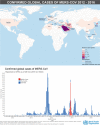The Middle East Respiratory Syndrome Coronavirus - A Continuing Risk to Global Health Security
- PMID: 27966107
- PMCID: PMC7119928
- DOI: 10.1007/5584_2016_133
The Middle East Respiratory Syndrome Coronavirus - A Continuing Risk to Global Health Security
Abstract
Two new zoonotic coronaviruses causing disease in humans (Zumla et al. 2015a; Hui and Zumla 2015; Peiris et al. 2003; Yu et al. 2014) have been the focus of international attention for the past 14 years due to their epidemic potential; (1) The Severe Acute Respiratory Syndrome coronavirus (SARS-CoV) (Peiris et al. 2003) first discovered in China in 2001 caused a major global epidemic of the Severe Acute Respiratory Syndrome (SARS). (2) The Middle East respiratory syndrome coronavirus (MERS-CoV) is a new corona virus isolated for the first time in a patients who died of severe lower respiratory tract infection in Jeddah (Saudi Arabia) in June 2012 (Zaki et al. 2012). The disease has been named Middle East Respiratory Syndrome (MERS) and it has remained on the radar of global public health authorities because of recurrent nosocomial and community outbreaks, and its association with severe disease and high mortality rates (Assiri et al. 2013a; Al-Abdallat et al. 2014; Memish et al. 2013a; Oboho et al. 2015; The WHO MERS-CoV Research Group 2013; Cotten et al. 2013a; Assiri et al. 2013b; Memish et al. 2013b; Azhar et al. 2014; Kim et al. 2015; Wang et al. 2015; Hui et al. 2015a). Cases of MERS have been reported from all continents and have been linked with travel to the Middle East (Hui et al. 2015a; WHO 2015c). The World Health Organization (WHO) have held nine meetings of the Emergency Committee (EC) convened by the Director-General under the International Health Regulations (IHR 2005) regarding MERS-CoV (WHO 2015c). There is wishful anticipation in the political and scientific communities that MERS-CoV like SARS-CoV will disappear with time. However it's been nearly 4 years since the first discovery of MERS-CoV, and MERS cases continue to be reported throughout the year from the Middle East (WHO 2015c). There is a large MERS-CoV camel reservoir, and there is no specific treatment or vaccine (Zumla et al. 2015a). With 10 million people visiting Saudi Arabia every year for Umrah and/or Hajj, the potential risk of global spread is ever present (Memish et al. 2014a; McCloskey et al. 2014; Al-Tawfiq et al. 2014a).
Keywords: Camels; Coronavirus; Drugs; Infection control; MERS; MERS-CoV; Middle East; Risk; Treatment.
Figures
References
MeSH terms
LinkOut - more resources
Full Text Sources
Other Literature Sources
Medical
Miscellaneous


